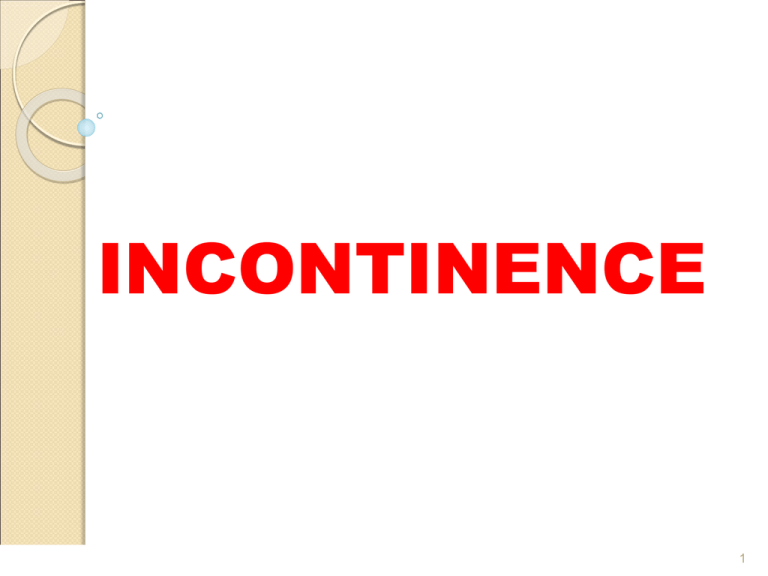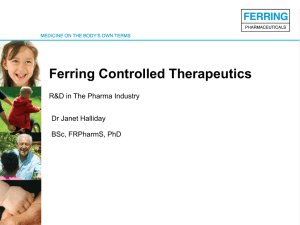
INCONTINENCE
WEA Hunter: Herbal Therapeutics 1 © 2009
1
Defined as “the involuntary loss of
urine due to increased bladder
pressures or decreased ability of the
vesicourethral sphincter to prevent
the escape of urine” (Porth 2002).
WEA Hunter: Herbal Therapeutics 1 © 2009
2
http://www.continence-foundation.org.uk/publications/
Despite popular opinion, incontinence as part of
the normal aging process is not the only cause.
10-25% of women between the ages of 15
and 64 experience incontinence at some
time.
It affects over 30% of community - living
adults
60% of residents in long-term aged care
facilities.
WEA Hunter: Herbal Therapeutics 1 © 2009
3
It affects:
◦ Teenage athletes
◦ Pregnant women – 50% of women who have
had children develop a prolapse.
◦ New mothers
◦ Menopausal women 45–60 years old
◦ Women after gynaecological surgery
Only 10–20% actually seek help
It has been estimated that urinary incontinence
costs the USA around $15 billion per year.
WEA Hunter: Herbal Therapeutics 1 © 2009
WEA Hunter: Herbal Therapeutics 1 © 2009
5
Causes
INHERITED OR GENETIC FACTORS
Anatomic difficulties
◦ Weakness of muscles that hold the bladder in
place or in the bladder itself
◦ Weakness of the urethral sphincter muscles
◦ Overactive bladder muscles.
◦ In men, a non-cancerous overgrowth of the
prostate gland, prostate cancer or prostate
surgery.
WEA Hunter: Herbal Therapeutics 1 © 2009
6
•
Neurological abnormalities
◦ Damage to the nerves controlling the bladder as a
result of diseases such as diabetes, stroke, Parkinson's
disease and multiple sclerosis.
◦ Hysterectomies and prostatectomies can weaken or
damage the muscles and nerves of the urinary tract
and can cause incontinence.
PHYSICAL FACTORS
Pregnancy and childbirth
◦ Pressure of the uterus and contents
◦ Connective tissue changes or injury to the fascia
◦ Mechanical disruption of muscles and sphincters
WEA Hunter: Herbal Therapeutics 1 © 2009
7
Aging
Hormonal effects
◦ High concentration of oestrogen receptors in pelvic
tissue.
◦ General collagen deficiency state or a decrease in
estrogen in post-menopausal women can reduce
the strength of the sphincter muscle.
◦ Urethral coaptation
affected by the loss of
oestrogen
◦ Non-obstetric pelvic trauma and / or surgery
Medications
WEA Hunter: Herbal Therapeutics 1 © 2009
8
TYPES
STRESS INCONTINENCE
Involuntary loss of urine during coughing, sneezing,
laughing or other physical activities that increase
intra-abdominal pressure.
Caused by
◦ a weakness of the pelvic floor muscles
◦ Structural damage to the bladder neck or urethral
sphincters following surgery or trauma
◦ Breakdown in bladder support secondary to birth,
trauma or age
Most common in younger premenopausal women
WEA Hunter: Herbal Therapeutics 1 © 2009
9
In men can be caused by
◦ congenital defect
◦ Trauma
◦ Surgery to the bladder outlet such as
prostatectomy
URGE INCONTINENCE
(Also called detrusor instability or an overactive bladder)
Hyperactivity of the bladder characterised by
spontaneous, uninhibited bladder contractions
with an urgency to void.
May or may not involve involuntary loss of
urine
WEA Hunter: Herbal Therapeutics 1 © 2009
10
Usually idiopathic although it can be linked to
◦ underlying neurological disease such as
Stroke
Parkinson’s disease
Multiple sclerosis
◦ Injury
◦ Aging
◦ Radiation to the lower abdomen
◦ Chronic bladder outlet obstruction causing a partial
destruction of the nerve endings that control bladder
excitability
◦ Inflammation or irritation of the bladder
WEA Hunter: Herbal Therapeutics 1 © 2009
11
◦ Disease conditions such as diabetes mellitus
◦ Drugs such as hypnotics, tranquillisers and sedatives
can interfere with the conscious inhibition of voiding,
leading to urge incontinence
◦ Diuretics also increase the flow of urine and may
contribute to urge incontinence
More common in older post-menopausal women
WEA Hunter: Herbal Therapeutics 1 © 2009
OVERFLOW INCONTINENCE
Loss of urine involuntarily secondary to a failure to
empty
Bladder capacity is reached then the bladder pressure
becomes so great that it overcomes any resistance to
the outlet
Symptoms
◦ Frequent or constant dribbling
◦ Urge / stress incontinence symptoms
◦ Recurrent urinary tract infections
WEA Hunter: Herbal Therapeutics 1 © 2009
13
Causes
Decreased bladder contractility
◦ Age
◦ Bladder over-distention
◦ Severe infections
◦ fibrosis
Bladder outlet obstruction
◦ Large cystoceles
◦ Urethral strictures
◦ Closed sphincters
WEA Hunter: Herbal Therapeutics 1 © 2009
14
Medications
◦ Diuretics causing the bladder to fill more
rapidly than usual
◦ Anticholinergics
bladder contractions
inhibit
overactive
◦ Psychotropics
◦ Alpha-adrenergic blockers relax smooth
muscle in the bladder neck and prostatic
urethra, decreasing urethral resistance
WEA Hunter: Herbal Therapeutics 1 © 2009
15
In males, one of the most common causes of
this is enlargement of the prostate gland
Another cause often overlooked is faecal
impaction. When a large bolus of stool forms
in the rectum, it can push against the urethra
and block the flow of urine
WEA Hunter: Herbal Therapeutics 1 © 2009
16
WEA Hunter: Herbal Therapeutics 1 © 2009
17
FUNCTIONAL INCONTINENCE
Results from a deficit in the ability to
perform toileting secondary to factors
outside the urinary tract e.g. chronic
physical or mental impairment
REFLEX INCONTINENCE
Unconscious incontinence
Common in paraplegics
WEA Hunter: Herbal Therapeutics 1 © 2009
18
Risk Factors – Age and Gender
50
Female
40
30
(%)
(%)
40
50
*
Male
20
*
*
*
10
0
0
15-39 years
40-59 years
60+ years
15-39 years
* Statistically significantly higher (chi square test, p < 0.05) than same sex 15-39.
40-59 years
60+ years
* Statistically significantly higher (chi square test, p < 0.05) than same sex 15-39.
Urinary
Stress incontinence
Urge incontinence
50
50
Male
40
Female
30
20
*
*
(%)
(%)
Female
30
20
10
40
Male
Male
Female
30
20
*
10
10
*
0
0
15-39 years
40-59 years
15-39 years
60+ years
Flatus incontinence
40-59 years
60+ years
* Statistically significantly higher (chi square test, p < 0.05) than same sex 15-39.
* Statistically significantly higher (chi square test, p < 0.05) than same sex 15-39.
Anal
Faecal incontinence
Source: SAHOS Autumn 1998
WEA Hunter: Herbal Therapeutics 1 © 2009
19
Risk Factors –
Overweight and Obesity
WEA Hunter: Herbal Therapeutics 1 © 2009
40
(%)
Greater prevalence
of urinary
incontinence in
overweight and
obese women, than
those with normal
BMI
*
50
*
Male
Female
30
20
10
0
Underw eight
Normal
Overw eight
Obese
* St at ist ically signif icant ly higher (chi square t est , p <0.05) t han same sex wit h normal BMI.
Source: SAHOS Spring 2001
Preventable?
Risk Factors –
Insufficient Physical Activity
50
WEA Hunter: Herbal Therapeutics 1 © 2009
(%)
Lower prevalence of
urinary incontinence
in women who did
sufficient physical
activity, than those
who engaged in no
activity
Which comes first?
Male
40
Female
30
*
20
10
0
No activity
Activity but not
sufficient
Sufficient activty
* Statistically significantly lower (chi square test, p < 0.05) than same sex who did no activity.
Source: SAHOS Spring 2001
21
TREATMENT PROTOCOL
For stress incontinence associated with mild vaginal
prolapse, herbs which boost oestrogenic activity for the
premenopausal woman as well as post menopausal
indications
Discorea villosa
Chamaelirium lutuem
Tribulus terrestis
◦ Is indicated for many conditions from impotence to
urolithiasis and incontinence.
Lignans (linseed)
WEA Hunter: Herbal Therapeutics 1 © 2009
22
Tone the bladder sphincter to reverse bladder
leakage problems
Equisetum arvense
◦ Hemostatic and collagen astringent for connective
tissue weakness accompanying nephritis, mucosa
astringent in UTI. (Moore, M. “HERBAL TINCTURES IN CLINICAL
PRACTICE, 2.0” Southwest School of Botanical Medicine)
Agropyron repens
Serenoa repens
Crataeva nurvala
◦ Provides relief from incontinence, frequency and
pain and an improvement in bladder tone. (Bone. K.
1997. “Clinical Application of Ayurvedic and Chinese Herbs”, Phytotherapy Press,
Warwick)
Agathosma betulina
WEA Hunter: Herbal Therapeutics 1 © 2009
23
Soothe and heal the urinary tract
Barosma betulina
◦ Inflammation of the urinary tract
◦ Cystitis, urethritis, dysuria with urging but little relief
(Moore, M. “HERBAL TINCTURES IN CLINICAL PRACTICE, 2.0” Southwest School
of Botanical Medicine)
Galium aparine
Agropyrens repens
◦ Any acute irritation of the urinary tract or kidneys,
with referred pain along flanks, pain on urination;
soothing, not disinfectant. (Moore, M. “HERBAL TINCTURES IN
CLINICAL PRACTICE, 2.0” Southwest School of Botanical Medicine)
Arctostaphylus uva-ursi
◦ Inflammation of the urinary tract and bladder
(Wichtl &
Bisset 2000)
WEA Hunter: Herbal Therapeutics 1 © 2009
24
Zea Mays
Equisetum arvense
◦ A diuretic that increases the flow through the
ureters, and is useful in inflammation (Wichtl & Bisset
2000)
Althea officinalis radix
Boosting the circulation to the pelvic region
Dong Quai
Ginkgo
WEA Hunter: Herbal Therapeutics 1 © 2009
25
RECURRENT KIDNEY
STONES
(NEPHROLITHIASIS)
WEA Hunter: Herbal Therapeutics 1 © 2009
26
Crystalline structures that form from components in
the urine.
Aetiology of urinary stone formation is complex and
is thought to involve a number of factors such as
◦ Increases in blood and urinary levels of stone
components
◦ Anatomic changes in urinary tract structures
◦ Metabolic and endocrine influences
◦ Dietary and intestinal absorption factors
◦ Urinary tract infections
◦ Low carbohydrate diets present a possible risk of
kidney stones and kidney disease
WEA Hunter: Herbal Therapeutics 1 © 2009
27
Kidney stones have an estimated Australian
prevalence rate of (Kron, J. 2008, ‘Kidney Stones’, The Journal of
Complementary Medicine, vol.7, no.6, pp.14-16)
6 – 9% in men
3 – 4% in women
Recurrence rate of 26 – 53% after 10 years
WEA Hunter: Herbal Therapeutics 1 © 2009
28
Three theories exist
The Saturation Theory the risk of stone formation
is increased when urine is supersaturated with stone
components. The greater the concentration, the more
likely to find precipitation
The matrix theory organic materials, such as
polysaccharides can be found in all layers of kidney
stones and either contribute to the initiation of the
stone formation or the material is entrapped as the
stone forms
The inhibitor theory people who have a deficiency
of proteins that inhibit stone formation in their urine
are at increased risk for stone formation. Much of the
information about organic inhibitors in terms of stone
formation is still experimental.
WEA Hunter: Herbal Therapeutics 1 © 2009
29
Types of stones:
Calcium stones (70-80%)
Usually occur as calcium oxalate and less commonly
as calcium phosphate
Associated with increased concentrations of calcium
in the blood and urine
Excessive bone resorption can be associated with
◦ Immobility
◦ Bone disease
◦ Hyperparathyroidism
◦ Renal tubular disorders resulting in excessive
leakage of clacium
◦ High oxalate concentrations in the blood and urine
WEA Hunter: Herbal Therapeutics 1 © 2009
30
Calcium containing calculi have been shown to
develop in up to 6% of people treated with
indinavir, a protease inhibitor used in HIV
infection
About 50% of patients with calcium stones have
excessive calcium in their urine. The most
common cause of this is a geneticallydetermined increased calcium absorption in the
intestine.
WEA Hunter: Herbal Therapeutics 1 © 2009
31
Other contributing factors could include
◦ Excessive urinary calcium can be caused by a diet
rich in sodium or animal protein or low in fluid
intake.
◦ Parathyroid hormone and vitamin D excess can lead
to hypercalcaemia and kidney stones.
◦ Low levels of citrate (affecting between 20 and 60%
of patients)
◦ Chronic diarrhoea
◦ Potassium loss
◦ Excessive physical exercise
◦ A high acid forming diet (rich in high protein foods)
WEA Hunter: Herbal Therapeutics 1 © 2009
32
Magnesium ammonium phosphate stones
(Struvite stones)
Form in alkaline urine and in the presence of bacteria
that possess an enzyme called urease, which splits the
urea in the urine into ammonia and carbon dioxide.
The increased ammonia helps to increase the pH of the
urine, making it more alkaline.
These stones enlarge as the bacterial count grows and
they can increase in size until they fill the entire renal
pelvis.
Because of their shape, they are often called staghorn
stones.
Treatment of the infection is often difficult.
Struvite stones are usually too large to pass and require
surgical removal or lithotripsy.
WEA Hunter: Herbal Therapeutics 1 © 2009
33
WEA Hunter: Herbal Therapeutics 1 © 2009
34
Uric acid stones
Develop in conditions of gout and high
concentrations of uric acid in the urine.
High uric acid levels contribute to calcium stone
formation by acting as a nucleus for calcium stone
formation
They form in urine with a pH of 5.1 to 5.9
A contributing factor could be a high purine diet
Cystine stones
Lithotripsy
Shock wave lithotripsy (SWL) uses high frequency sound waves
from an external source (outside the body) to break a kidney
stone into small pieces, and allow it to pass through the urinary
tract.
WEA Hunter: Herbal Therapeutics 1 © 2009
WEA Hunter: Herbal Therapeutics 1 © 2009
Manifestations
Pain
Renal colic
◦ Caused by stones 1–5mm in diameter that move into
the ureter and obstruct flow
◦ Acute, intermittent and excruciating pain in the
upper quadrant of the abdomen on the affected side
◦ The pain may radiate to the lower abdominal
quadrant , bladder area, perineum or scrotum in the
male
◦ The skin may be cool and clammy
◦ Nausea and vomiting are common
WEA Hunter: Herbal Therapeutics 1 © 2009
37
Non-colicky renal pain
◦ Caused by stones that cause distension of the renal
calculi or renal pelvis
◦ The pain is usually a dull, deep ache in the back that
can vary in intensity from mild to severe
◦ The pain may be exaggerated by drinking large
amounts of fluid
Blood in the urine
Increased frequency of urination
Pain and burning during urination
Fever, chills, loss of appetite
Urinary tract infection
WEA Hunter: Herbal Therapeutics 1 © 2009
38
Treatment protocol
Prevention of kidney stones and the treatment of
existing stones
Crataeva nurvala
◦ A clinical study on the effects of Crataeva on 46
patients with kidney, ureter or bladder stones not
requiring surgery found that 26 patients passed the
stones within 10 weeks of treatment. The majority of
the remaining patients experienced symptom relief.
(Bone. K. 1997. “Clinical Application of Ayurvedic and Chinese Herbs”, Phytotherapy
Press,Warwick)
◦ Shows a decreased tendency to form calcium oxalate
kidney stones. In an in vivo study, it was found that the
weight of stones decreased, the bladders of rats
showed less ulceration and less cellular infiltration
when compared to controls. (Bone. K. 1997. “Clinical Application of
Ayurvedic and Chinese Herbs”, Phytotherapy Press,Warwick)
WEA Hunter: Herbal Therapeutics 1 © 2009
39
Equisetum arvense
◦ One of the richest sources of natural silica, a mineral
which helps healthy calcium metabolism
◦ Supports healthy urine production
◦ German Commission E lists it for static oedema,
bacterial infections and inflammation of the lower
urinary tract and for renal gravel.
Eupatorium purpureum
◦ Traditionally used as a treatment for stones and
gravel in the kidneys
Taraxacum officinalis folia
◦ Grieve (1973) states that it is “a strong decoction
that is found to be servicable in stone and gravel”
WEA Hunter: Herbal Therapeutics 1 © 2009
40
Hydrangea aborescens
◦ Pyelitis, urethritis, prostatitis; to reduce ureter colic
pain and mucosa inflammation (Moore, M. “HERBAL
TINCTURES IN CLINICAL PRACTICE, 2.0” Southwest School of Botanical
Medicine)
◦ Inflammation of the bladder, urethra and prostate
and kidney stones. (Bone, K. 2005)
◦ Sedative effect on the urinary tract
◦ Used in the treatment of kidney stone
Capsella bursa
Urinary astringent in urethritis
prevention of urate stones.
WEA Hunter: Herbal Therapeutics 1 © 2009
and
the
41
Pain relief
Viburnum opulus
◦ Relaxes smooth muscle
◦ antispasmodic
Dioscorea villosa
Corydalis ambigua
◦ Almost any type of pain, but particularly visceral
pain. It strengthens the analgesic function and has a
sedative action as well. (Bone. K. 1997. “Clinical Application of
Ayurvedic and Chinese Herbs”, Phytotherapy Press,Warwick)
Caulophyllum thalictroides
◦ Used specifically for smooth muscle spasm and
cramping (Bone, K. 2003)
WEA Hunter: Herbal Therapeutics 1 © 2009
42
Damage to the urinary tract mucosa
Immune enhancing
Demulcents
◦ Zea mays
◦ Althea officinalis radix
◦ Licorice
Anti-inflammatory action – in vitro studies have
shown it has mucoprotective effects allowing tissue
and gut repair (Braun & Cohen, 2005)
Urinary tract antiseptics
◦ Arctostaphylos uva ursi
WEA Hunter: Herbal Therapeutics 1 © 2009
43
Binding of calcium in the urine and making it
less likely to precipitate – anthraquinone
containing herbs
Cascara
Yellow dock
Infection as it can be a cause of stone formation
◦ Galium aparine
◦ Echinacea spp.
WEA Hunter: Herbal Therapeutics 1 © 2009
44
Increasing fluid intake will help to prevent stone
formation by reducing crystal salt concentration and
increasing their expulsion. (Kron, J. 2008, ‘Kidney Stones’, The
Journal of Complementary Medicine, vol.7, no.6, pp.14-16)
◦ The recommendation is to drink enough water to
produce 2 – 2.3 litres of urine each day. Other
beverages are additional to water.
◦ No RCTs have been done for specific beverages,
however, non-controlled studies have found that
orange juice and lemonade increase urinary pH
levels and citrate excretion.
◦ Prospective studies have found that coffee, beer and
wine are associated with reduced stone formation
risk due to increased urinary volume, whereas
grapefruit juice and apple juice are associated with
an increased risk, although the reason why is not
know.
WEA Hunter: Herbal Therapeutics 1 © 2009
45
(Kron,
J. 2008, ‘Kidney Stones’, The Journal of Complementary Medicine, vol.7,
no.6, pp.14-16) makes the following recommendations:
Protein Animal protein (meat, poultry and fish) is
regarded as increasing stone-formation risk due to
increased urinary calcium, uric acid and phosphate
excretion and reduced citrate and urine pH. The
animal protein recommendation is 20g/day
Salt mixed results from cohort studies but it is felt
that salt is associated with increased stone formation
due to increased urinary calcium and uric acid
excretion and decreased citrate excretion.
Dairy a high calcium intake is regarded as
decreasing stone formation risk by reducing gut
absorption of oxalates through calcium binding to
them.
WEA Hunter: Herbal Therapeutics 1 © 2009
46
Increased vitamin D intake combined with calcium
supplementation increases calcium excretion due to
excessive blood calcitriol or overregulation of its
receptors, leading to excessive absorption of gut
calcium.
◦ It is recommended that vitamin D supplementation
be avoided except in people with hypovitaminosis D
Magnesium is regarded as decreasing gut absorption
of oxalate. A systemic review found that the addition
of magnesium to potassium citrate therapy improves
outcomes.
WEA Hunter: Herbal Therapeutics 1 © 2009
47
Lifestyle (Bone, K. 2004)
Regular weight bearing exercise will help store
calcium in bones, which would otherwise be
excreted in the urine. However, be aware that
excessive exercise increases dehydration and
cause lactic acidosis, a factor in stone formation.
Avoid commercial drinks as they are often loaded
with phosphate and sugar.
Diet should be based on fruit, vegetables and
unrefined carbohydrates. Fruits rich in potassium
and citrate should be emphasised together with
foods rich in magnesium such as fermented soya
products, legumes, nuts and green leafy
vegetables.
WEA Hunter: Herbal Therapeutics 1 © 2009
48
Calcium intake should not be excessive but
should also not be restricted. Restriction of
calcium can lead to excessive oxalate
absorption
If there is a history of oxalate stones, then
oxalates are to be avoided rhubarb,
spinach, strawberries, ginger, almonds,
cashews, beetroot, tea and chocolate
WEA Hunter: Herbal Therapeutics 1 © 2009
49
The average pH of soft drinks, e.g. Coke &
Pepsi is 3.4. This acidity is strong enough to
dissolve teeth and bones! Our human body
stops building bones at around the age of 30.
After that, it shall dissolve the bones every
year through the urine depending on the
acidity of the food intake. All the dissolved
calcium compounds, get accumulated in the
arteries, veins, skin, tissue and organs, which
affects the functioning of the kidney assisting
in formation of kidney stones.
WEA Hunter: Herbal Therapeutics 1 © 2009
50
CASE STUDY – URINARY SYSTEM
Presenting:
Over the past 18months has had a history of recurrent
urinary tract infections
Her main symptoms were:
◦ Lower abdominal pain and Left groin pain
Constant but improves for 5 minutes after urinating
◦ Burning / stinging pain around the urethra, worse if
sitting, OK if lying
◦ Urge incontinence beginning to become a problem
Having to urinate every 30 – 60 minutes
◦ No nocturia
◦ No pain during urination
◦ A recent test found traces of blood in her urine
WEA Hunter: Herbal Therapeutics 1 © 2009
51
On further questioning the following became known
◦ She has had a long history of lower back pain with sciatica and
osteoarthritis L4-5
◦ Has osteoarthritis in the hips, knees and hands
◦ Cytoscopy has confirmed that Hunner’s Ulcers are present as
well as wide spread patchy redness
◦ She has used an NSAID (Orudis) as needed for years
◦ Has a past history of migraines
◦ She is menopausal and currently on HRT (Premarin)
◦ Has been diagnosed as having irritable bowel in the last 6
months
Energy
◦ Normally good
◦ Needs a break about 2.30pm – the worse time is mid to late
afternoon
◦ Gradually getting worse over the past 12 month
WEA Hunter: Herbal Therapeutics 1 © 2009
52
Diet:
◦ Breakfast Wheat bix / full cream milk / tea with
milk and 1 sugar / make up orange juice
◦ Morning tea Tea with milk and 1 sugar / raison
toast
◦ Lunch
Feels as though she wants to eat a big meal
Has a combination of whatever she can find in the
fridge / cupboard
Tea with milk and 1 sugar
◦ Afternoon tea Water
◦ Dinner
Picking at whatever she can find
Lately craving meat
Not eating any fruit and vegetables
WEA Hunter: Herbal Therapeutics 1 © 2009
53
◦ Fluid intake
Water up to 1 litre per day
Tea 5 – 6 per day (all with milk and 1
sugar)
Make up cordial 2 per day
Alcohol none
Stress
◦ Feels stressed within the family group
however, feels okay if she can control her
surroundings
◦ Concerned about her daughter who looks
like she is developing similar heath problems
◦ Very emotional about a difficult son
WEA Hunter: Herbal Therapeutics 1 © 2009
54
Smoke no and never
Medications as listed earlier
Supplements none
Blood pressure normal
WEA Hunter: Herbal Therapeutics 1 © 2009
55









